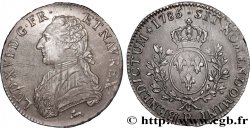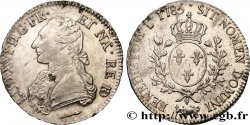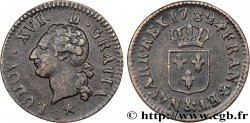fme_622355 - LOUIS XVI Médaille, Canal du Centre
non disponibile.
Articolo venduto sul nostro negozio (2022)
Prezzo : 150.00 €
Articolo venduto sul nostro negozio (2022)
Prezzo : 150.00 €
Tipo : Médaille, Canal du Centre
Data: 1783
Metallo : rame
Diametro : 50 mm
Asse di coniazione : 12 h.
Incisore DUVIVIER Benjamin (1730-1819)
Peso : 60,42 g.
Orlo : lisse
Marchio : sans poinçon
Commenti sullo stato di conservazione:
Joli exemplaire présentant néanmoins plusieurs coups et rayures. Traces de manipulation et des taches dans les champs
Diritto
Titolatura diritto : LUDOVICO XVI. FR. ET NAVAR. REGI OPTIMO // À L’EXERGUE : COMITIA BURGUNDIAE.
Descrittivo diritto : Buste habillé et drapé de louis XVI à droite. Signé sous le buste : DU VIVIER.
Rovescio
Titolatura rovescio : UTRIUSQUE MARIS JUNCTIO TRIPLEX // À L’EXERGUE : FOSSIS AB ARARI / AD LIGERIM SEQUANAM ET RHENUM / SIMUL APERTIS / MDCCLXXXIII.
Descrittivo rovescio : La Bourgogne personnifiée assise avec une corne d’abondance et de bouclier à ses pieds, tenant un caducée de la main droite ; autour d’elle les dieux fleuves du Rhin, de la Saône et de la Loire. Signé à l’exergue : DU VIVIER.
Commento
Le canal du Centre relie les vallées de la Loire et de la Saône. Le canal est également connu comme canal du Charolais.
La Dheune, affluent de la Saône, et la Bourbince, affluent de la Loire, ont depuis longtemps (XVe-XVIe siècles) retenu l'attention des ingénieurs par l'orientation de leurs cours qui permettaient d'envisager une liaison entre le sillon rhodanien et la Méditerranée d'une part, et l'Atlantique ou la Manche, la Loire étant elle-même reliée à la Seine depuis 1642 par le canal de Briare. Le projet soutenu par l'ingénieur Thomassin est d'abord en concurrence avec le canal de Bourgogne mais les deux canaux seront finalement réalisés.Le grand artisan du canal du Centre est Émiland Gauthey (1732-1806), ingénieur des États de Bourgogne : son projet élaboré et modifié pendant plusieurs années est approuvé en 1782 par le Parlement de Bourgogne et réalisé de 1784 à 1791/1793 sous son autorité. Appelé à l'origine « canal du Charolais », l'ouvrage, alimenté par les étangs et les divers cours d'eau des bassins versants, comprend un canal latéral à la Bourbince de Digoin à Montceau-les-Mines, un canal à bief de partage de Montceau à Saint-Julien-sur-Dheune, un canal latéral à la Dheune de Saint-Julien à Chagny, un canal de jonction par dérivation de la Dheune vers la Thalie par la tranchée de Chagny à Rully et un canal latéral à la Thalie de Rully à Chalon-sur-Saône. À l'initiative d’Émiland Gauthey, on a préféré le tracé le plus court en ne suivant pas le cours inférieur de la Dheune : celui-ci manquait de profondeur et présentait de grandes variations de débit (sécheresse et inondations) avec de nombreux méandres et parfois plusieurs bras, de plus la rivière n'aboutissait pas à un port.
The Canal du Centre links the Loire and Saône valleys. The canal is also known as the Charolais Canal.
The Dheune, a tributary of the Saône, and the Bourbince, a tributary of the Loire, have long (15th-16th centuries) attracted the attention of engineers due to the orientation of their courses which made it possible to envisage a link between the Rhone valley and the Mediterranean on the one hand, and the Atlantic or the Channel, the Loire itself being linked to the Seine since 1642 by the Briare Canal. The project supported by engineer Thomassin was initially in competition with the Burgundy Canal, but both canals were ultimately completed.. The main architect of the Canal du Centre was Émiland Gauthey (1732-1806), engineer of the States of Burgundy: his project, developed and modified over several years, was approved in 1782 by the Parliament of Burgundy and carried out from 1784 to 1791/1793 under his authority.. Originally called the \\\"Charolais Canal\\\", the structure, fed by the ponds and various watercourses in the watersheds, includes a lateral canal to the Bourbince from Digoin to Montceau-les-Mines, a canal with a watershed from Montceau to Saint-Julien-sur-Dheune, a lateral canal to the Dheune from Saint-Julien to Chagny, a junction canal by diversion from the Dheune to the Thalie via the Chagny trench to Rully and a lateral canal to the Thalie from Rully to Chalon-sur-Saône. At the initiative of Émiland Gauthey, the shorter route was preferred by not following the lower course of the Dheune: this lacked depth and presented large variations in flow (drought and floods) with numerous meanders and sometimes several arms, moreover the river did not end at a port
La Dheune, affluent de la Saône, et la Bourbince, affluent de la Loire, ont depuis longtemps (XVe-XVIe siècles) retenu l'attention des ingénieurs par l'orientation de leurs cours qui permettaient d'envisager une liaison entre le sillon rhodanien et la Méditerranée d'une part, et l'Atlantique ou la Manche, la Loire étant elle-même reliée à la Seine depuis 1642 par le canal de Briare. Le projet soutenu par l'ingénieur Thomassin est d'abord en concurrence avec le canal de Bourgogne mais les deux canaux seront finalement réalisés.Le grand artisan du canal du Centre est Émiland Gauthey (1732-1806), ingénieur des États de Bourgogne : son projet élaboré et modifié pendant plusieurs années est approuvé en 1782 par le Parlement de Bourgogne et réalisé de 1784 à 1791/1793 sous son autorité. Appelé à l'origine « canal du Charolais », l'ouvrage, alimenté par les étangs et les divers cours d'eau des bassins versants, comprend un canal latéral à la Bourbince de Digoin à Montceau-les-Mines, un canal à bief de partage de Montceau à Saint-Julien-sur-Dheune, un canal latéral à la Dheune de Saint-Julien à Chagny, un canal de jonction par dérivation de la Dheune vers la Thalie par la tranchée de Chagny à Rully et un canal latéral à la Thalie de Rully à Chalon-sur-Saône. À l'initiative d’Émiland Gauthey, on a préféré le tracé le plus court en ne suivant pas le cours inférieur de la Dheune : celui-ci manquait de profondeur et présentait de grandes variations de débit (sécheresse et inondations) avec de nombreux méandres et parfois plusieurs bras, de plus la rivière n'aboutissait pas à un port.
The Canal du Centre links the Loire and Saône valleys. The canal is also known as the Charolais Canal.
The Dheune, a tributary of the Saône, and the Bourbince, a tributary of the Loire, have long (15th-16th centuries) attracted the attention of engineers due to the orientation of their courses which made it possible to envisage a link between the Rhone valley and the Mediterranean on the one hand, and the Atlantic or the Channel, the Loire itself being linked to the Seine since 1642 by the Briare Canal. The project supported by engineer Thomassin was initially in competition with the Burgundy Canal, but both canals were ultimately completed.. The main architect of the Canal du Centre was Émiland Gauthey (1732-1806), engineer of the States of Burgundy: his project, developed and modified over several years, was approved in 1782 by the Parliament of Burgundy and carried out from 1784 to 1791/1793 under his authority.. Originally called the \\\"Charolais Canal\\\", the structure, fed by the ponds and various watercourses in the watersheds, includes a lateral canal to the Bourbince from Digoin to Montceau-les-Mines, a canal with a watershed from Montceau to Saint-Julien-sur-Dheune, a lateral canal to the Dheune from Saint-Julien to Chagny, a junction canal by diversion from the Dheune to the Thalie via the Chagny trench to Rully and a lateral canal to the Thalie from Rully to Chalon-sur-Saône. At the initiative of Émiland Gauthey, the shorter route was preferred by not following the lower course of the Dheune: this lacked depth and presented large variations in flow (drought and floods) with numerous meanders and sometimes several arms, moreover the river did not end at a port








 Segnalare un errore
Segnalare un errore Stampate la pagina
Stampate la pagina Condividi mia selezione
Condividi mia selezione Fai una domanda
Fai una domanda Consegnare / vendere
Consegnare / vendere
 Descrittivo
Descrittivo










